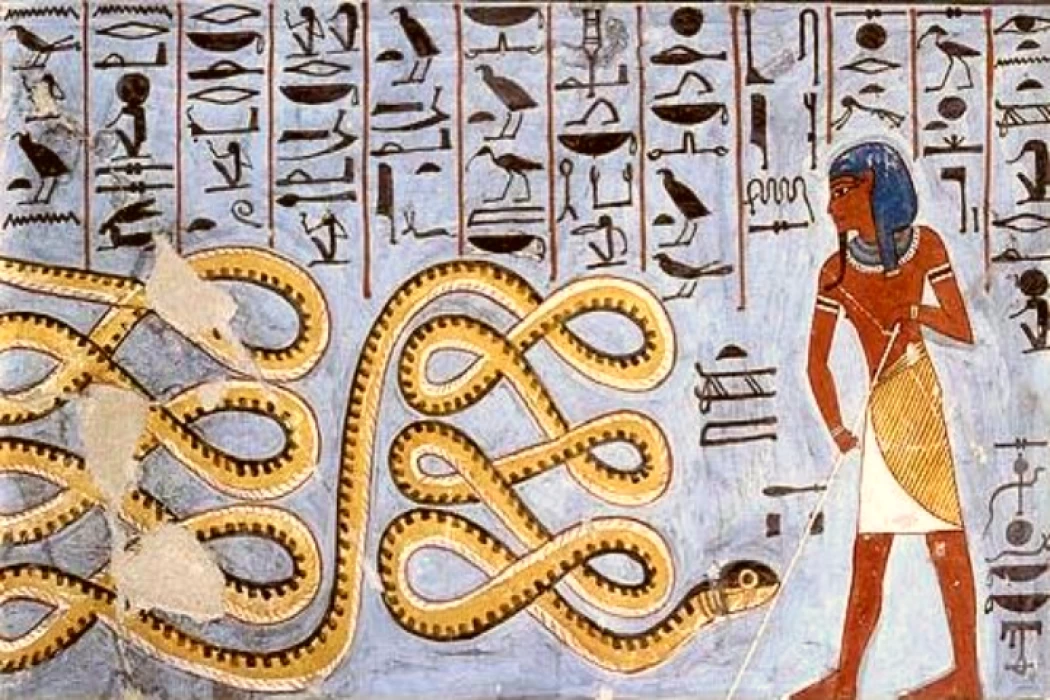
History of Apophis the Egyptian God | God Apep
Apophis (or Aviv, Abebe, Aviv), (Greek: ἄπορις) is an evil snake in ancient Egyptian mythology, considered a symbol of evil, and as such is the enemy of the "symbolic good" Ra and MAAT "truth and Justice". Abu vis embodies all that is evil, he forms part of the most complex cosmic system of identification of RA and atom, that is, the creation of Atom-Ra.
According to scientists specializing in the history of ancient Egypt, it was found that the pronunciation of his name is "aababi", which was later pronounced: "avov" (Coptic: Ⲁⲫⲱⲫ).Formal description Abu Vis is a huge snake, which has an enormous size and wraps around itself several times, often appearing in drawings on the walls of temples, being defeated or killed by one of the icons.
He also painted in the form of a huge lizard, or a crocodile, and later in the form of a dragon. His role in Egyptian mythology, Ra in the form of a cat, slaughters Abu Feis. The legend tells about Apophis that he causes constant battles between him and RA, and Apophis attacks the sun boat every morning to prevent it from sailing towards the horizon.
Sometimes he has the upper hand in the fight, earthquakes, storms and thunder occur, and he may win and swallow the sun, and it happens with this eclipse. His respect for Pharaoh Epsilon the first makes offerings to help atom Abu vis as a symbol of evil was not directly respected, but for his connection with cosmic disasters, Defeated every day by RA, it was believed that she needed prayers from the priests of Egypt and worshipers in the temples, so the Egyptians practiced several rituals that they believed to ward off Apophis to help RA continue his journey through heaven. In an annual ritual, in order to keep Apophis away and in order to prevent his evil, the priests burned his statues to protect everyone from the influence of Apophis for another month.
Apophis is the nice Serpent, the enemy of the sun god Ra, in ancient Egyptian faith. The sun was Ra's nice barge that sailed through the sky from dawn to twilight and descended into the underworld. because it sailed through the darkness, it absolutely was attacked by Apophis who sought-after to kill Ra and forestall sunrise.
On board, the nice ship variety of various gods and goddesses are delineated in differing eras similarly because the even dead and every one of those helped deflect the serpent. Ancient Egyptian monks and laypeople would interact in rituals to guard Ra and destroy Apophis and, through these observances, connected the living with the dead and therefore the existence as established by the gods.
Defeated every day by Ra. Legend tells of Apophis causing constant battles between him and Ra. Apophis attacks the sun boat every morning to prevent it from sailing towards the horizon, is defeated every time, and returns every morning.
Sometimes he has the upper hand in combat, and earthquakes, storms, and thunder occur. He may win and swallow the sun, and this eclipse occurs, but the guards of the sun boat accompanying Ra quickly cut off his head, so the eclipse only lasts a few minutes. It is likely that this is the ancient Egyptians' explanation for the phenomenon of eclipses
Apophis ne'er had a proper cult and was ne'er adored, however, he would feature during a variety of tales managing his efforts to destroy the sun god and come back the order to chaos. Apophis is related to earthquakes, thunder, darkness, storms, and death, and is typically connected to the god Set, conjointly related to chaos, disorder, storms, and darkness. Set was originally a shielder god, however, and seems to be a variety of times because the strongest of the gods on board the sun god's sailing ship, defensive the ship against Apophis.
Apep was 1st mentioned within the Eighth kinfolk, and he was worthy within the names of the Fourteenth kinfolk king Apepi and therefore the larger Hyksos king Apophis. every night Apopis encountered Re at a selected hour within the sun god’s ritual journey through the underworld in his divine sailing ship. Seth, who rode as guardian ahead of Re’s sailing ship, attacked him with a spear and slew him, however consecutive nights Apophis, who couldn't be for good subdued, was there once more to attack Re.
The serpent Apophis (Apophis) faces the boat; he wants to dry up this region by swallowing the water, which has been found in such a way that the boat will not be able to continue on its course. But then Abu Vis embodies a clip into pieces, there is a god who cuts him and another god who strangles him.
Apophis was depicted trying to obstruct Ra's boat and was also dismembered at seven o'clock by the ancient Egyptians, with the Egyptians engraving the 12 hours in inscriptions on the walls.
In an annual ritual, the priests, in order to keep Abu Vis away and avoid his evil, burned his statues to protect everyone from Abu Vis' influence for another year.
The process of getting rid of and protecting Abu Vis was described, and these rituals include the following:
Spitting on Apophis.
Place the left foot on Apophis' head.
Apophis was stabbed with a spear.
Stifling and restraining Apophis
Apophis was slaughtered using a knife.
Setting fire to Apophis















